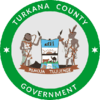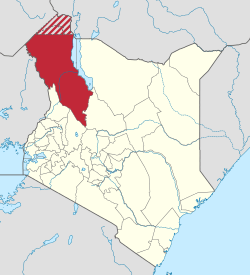Turkana County
Turkana County is a county in the former Rift Valley Province of Kenya. Turkana is the largest County, by land area, followed by Marsabit County and also the northwesternmost county in Kenya. It is bordered by the countries of Uganda to the west; South Sudan and Ethiopia, including the disputed Ilemi Triangle, to the north and northeast; and Lake Turkana to the east. To the south and east, neighbouring counties in Kenya are West Pokot, Baringo and Samburu Counties, while Marsabit County is located on the opposite (i.e. eastern) shore of Lake Turkana. Its capital and largest town is Lodwar. According to the 2019 census, Turkana County has a population of 926,976.[2]
Turkana County | |
|---|---|
Lake Turkana Aerial Photo | |
 Flag  Coat of arms | |
 Location of Turkana County (red) including the disputed Elemi Triangle (diagonally striped red) | |
| Coordinates: 3°09′N 35°21′E | |
| Country | |
| Formed | 4 March 2013 |
| Capital | Lodwar |
| Government | |
| • Governor | Josphat Koli Nanok[1] |
| Area | |
| • Total | 68,680 km2 (26,520 sq mi) |
| Elevation | 1,138 m (3,734 ft) |
| Population (2019) | |
| • Total | 926,976 |
| • Density | 13/km2 (35/sq mi) |
| Time zone | UTC+3 (EAT) |
| Website | turkana.go.ke |
History
Four sites of Stone Age cultures are situated upon tributaries along the west side of Lake Turkana in West Turkana; at Lokalalei, Kokiselei and Nadungu, and became of interest to archaeology beginning sometime during 1988.[3][4][5]
The earliest late Stone age industries in prehistory were found in Turkana, at the site of Lomekwi, and date to 3,300,000 years.[6][7] At the archaeological site of Nataruk, in Southwest Turkana, scientists have discovered the oldest evidence of inter-group conflict in the past, establishing that warfare occurred between groups of hunter-gatherers.[8]
Direct influence by colonial forces, in the form of pacification within the district began in 1900 and ended in 1918.[9]
During 1926, the entire Turkana people were placed under British military administration, who subsequently restricted their movements to the Turkana region.[10][11]
During 1958, the district experienced an influx of a number of people classified as belonging to the Turkana people. These had been expelled from the Kenyan town of Isiolo, and forcibly relocated to the Turkana district by the British colonial administration.[12]
The district maintained an all but complete isolation until 1976 when road-blocks leading to the district were lifted.[13]
In 2000, the people in the north of the county were reported as being harassed by marauding Ethiopians, and were consequently forced to relocate in southern areas.[14]
Population
| Year | Pop. | ±% |
|---|---|---|
| 1979 | 142,702 | — |
| 1989 | 184,060 | +29.0% |
| 1999 | 450,860 | +145.0% |
| 2009 | 855,399 | +89.7% |
| 2019 | 926,976 | +8.4% |
| source:[15] | ||
Language
Turkana is known in the local language as ng'turkana.[16] Some place names in the country are attributed to the language of the Pokot and Samburu peoples, representing a tradition in the area of inhabitation by these peoples prior to displacement by the Turkana.[17]
Geography
The county is within the boundaries of the former Rift Valley province.[18] According to data provided during 1991 the majority of the population at that time lived by way of farming.[19] With an area of nearly 77,000 km2, Turkana is the largest county, including the area covered by Lake Tukana, in Kenya.
Turkana County is emerging to be a major source of electric power in Kenya. Kengen's Turkwel Hydro Power Plant, situated on the southwest of Turkana County, produces hydroelectric power which is connected to the national power grid at Lessos. The county is current subject of crude oil exploration in Block 10BB and Block 13T and has potential for geothermal, solar and wind energy.
Kekarongole and Katilu had irrigation networks made commencing sometime during or after 1975.[20]
Rainfall measurements per annum (1982 data) is recorded as less than ten inches; with a range of between 115mm and 650mm.[21][22]
There were thirteen drought periods in a period of 50 years beginning 1938.[23]
Economics
Turkana is the poorest region in Kenya.[24] The county is, however, experiencing upward reviews due to ongoing mineral explorations and inventions, especially of oil and water resources. Turkana County residents are also enjoying the fruits of devolution. Devolution of power in Kenya is viewed as a blessing for the forgotten people of Turkana. It has been received in the sub- counties with much appreciation due to its direct benefits to the citizens. The current administration shares out these benefits equally to all sub counties in addition to enhancing citizen participation in development activities.
On 26 March 2012, Kenyan President Mwai Kibaki announced that oil had been discovered in Turkana County after exploratory drilling by Anglo-Irish firm Tullow Oil, and he further stated that
It is... the beginning of a long journey to make our country an oil producer, which typically takes in excess of three years. We shall be giving the nation more information as the oil exploration process continues.[25]
Gold panning was reported (2005) as occurring at Lochoremoit, Namoruputh, Lokiriama and Ng, akoriyiek.[26]
According to Barrett (2001) cited in Watson the wealth of a person is kept in the form of cattle.[27]
Figures stated as of 1998 stated an average estimated herd size of 15–20.[28]
In 2013 it was announced by UNESCO[29] that large reserves of groundwater had been discovered in Turkana County. The water was discovered using satellite exploration technology then confirmed by drilling.[30] The extraction of the water began in 2014 and it is being piped to provide water to Lodwar town for irrigation and water for the people.[31]
Government [Turkana County Government Website: http://www.turkana.go.ke/]
Promulgation of the Constitution of Kenya 2010 marked a momentous point in the country's history. The Constitution provided for, among others, enhanced checks and balances within the government, an enhanced role of Parliament and citizens, an independent judiciary, and a most progressive Bill of Rights. . Turkana County is one of the 47 counties of Kenya. The County is led by H.E. Governor Josphat Koli Nanok and Turkana County has 10 Ministries
County subdivisions
| Local authorities (councils) | |||
| Authority | Type | Population* | Urban pop.* |
|---|---|---|---|
| Lodwar | Municipality | 1,000,000 | 16,981 |
| Turkana | County | 414,963 | 26,563 |
| Total | - | 450,860 | 43,544 |
| * 1999 census. Source: | |||
| Administrative divisions | |||
| Division | Population* | Population density |
Headquarters |
|---|---|---|---|
| Central | 35,919 | 45 | Lodwar |
| Kaaling | 24,053 | 3 | |
| Kainuk | 11,799 | 7 | Kainuk |
| Kakuma | 97,114 | 26 | Kakuma |
| Kalokol | 28,735 | 5 | Kalokol |
| Katilu | 12,548 | 10 | katilu |
| Kerio | 15,409 | 6 | |
| Kibish | 6,056 | - | |
| Lapur | 12,780 | 6 | |
| Lokichar | 21,791 | 5 | Lokichar |
| Lokichogio | 36,187 | 5 | Lokichogio |
| Lokitaung | 22,586 | 12 | Lokitaung |
| Loima | 33,979 | 10 | Lorugum |
| Lokori | 17,915 | 3 | |
| Lomelo | 6,088 | 1 | Kapedo |
| Oropol | 18,020 | 3 | Oropol |
| Turkwel | 49,881 | 9 | |
| Total | 450,860 | 7 (average) | - |
| * 1999 census. Sources: | |||
The county has six constituencies:
- Loima Constituency
- Turkana Central Constituency
- Turkana East Constituency
- Turkana North Constituency
- Turkana South Constituency
- Turkana West Constituency
The counties have six sub counties
| sub-county | headquarters |
|---|---|
| Turkana Central | Lodwar |
| Turkana North | Lokitaung |
| Turkana South | Lokichar |
| Turkana East | Lokori |
| Turkana West | Kakuma |
| Loima | Lorugum |
Villages and settlements
See also
- Eliye Springs, a village located in Kalokol division
- Kenyans for Kenya
- Ilemi Triangle
References
- "Governor Turkana County". turkana.go.ke. Retrieved 7 January 2018.
- "2019 Kenya Population and Housing Census Volume I: Population by County and Sub-County". Kenya National Bureau of Statistics. Retrieved 6 November 2019.
- B S Blades, B Adams - Lithic Materials and Paleolithic Societies John Wiley & Sons, 12 May 2009 Retrieved 2012-07-08 ISBN 1405168374
- C R Ewen -Artifacts Rowman Altamira, 1 Apr 2003 Retrieved 2012-07-08 ISBN 0759100225
- (secondary) D Waugh - Geography: An Integrated Approach ISBN 017444706X Retrieved 1994
- Harmand, Sonia; Lewis, Jason E.; Feibel, Craig S.; Lepre, Christopher J.; Prat, Sandrine; Lenoble, Arnaud; Boës, Xavier; Quinn, Rhonda L.; Brenet, Michel (2015). "3.3-million-year-old stone tools from Lomekwi 3, West Turkana, Kenya". Nature. 521 (7552): 310–315. doi:10.1038/nature14464. PMID 25993961.
- C Ehret, M Posnansky - The Archaeological and Linguistic Reconstruction of African History University of California Press, 1982 Retrieved 2012-07-08 ISBN 0520045939
- Lahr, M. Mirazón; Rivera, F.; Power, R. K.; Mounier, A.; Copsey, B.; Crivellaro, F.; Edung, J. E.; Fernandez, J. M. Maillo; Kiarie, C. (2016). "Inter-group violence among early Holocene hunter-gatherers of West Turkana, Kenya". Nature. 529 (7586): 394–398. doi:10.1038/nature16477. PMID 26791728.
- T G Grenham - The Unknown God: Religious And Theological Interculturation Peter Lang, 2005 Retrieved 2012-07-08 ISBN 3039102613
- S Williams - Ian Hodder (ed) - The Archaeology of Contextual Meanings Cambridge University Press, 6 Aug 1987 Retrieved 2012-07-08 ISBN 0521329248
- Merriam-Webster dictionary online
- V Broch-Due, R A Schroeder - Producing Nature and Poverty in Africa Nordic Africa Institute, 2000 Retrieved 2012-07-08 ISBN 9171064524
- D McNeill, S D Duncan, J Cassell, E T Levy - Gesture and the Dynamic Dimension of Language: Essays in Honor of David McNeill John Benjamins Publishing Company, 2007 Retrieved 2012-07-08 ISBN 9027228418
- Traditional Occupations of Indigenous and Tribal Peoples: Emerging Trends International Labour Organization, 2000 Retrieved 2012-07-08
- Kenya: Administrative Division population statistics
- P. H. Gulliver - The Family Herds: A Study of Two Pastoral Tribes in East Africa, the Jie and Turkana Routledge, 31 Jan 2003 Retrieved 2012-07-08 ISBN 0415176468
- NC Dorian - Investigating Obsolescence: Studies in Language Contraction and Death Cambridge University Press, 3 Sep 1992 Retrieved 2012-07-08 ISBN 0521437571
- N Middleton, P O'Keefe - Disaster And Development: The Politics of Humanitarian Aid Pluto Press, 20 Nov 1997 Retrieved 2012-07-08 ISBN 0745312241
- W Critchley - Looking After Our Land: Soil and Water Conservation in Dryland Africa p.45- Oxfam, 1991 Retrieved 2012-07-08 ISBN 0855981709
- B Calas, CA Mumma Martinon - Shared Waters, Shared Opportunities: Hydropolitics in East Africa African Books Collective, 30 Nov 2010 Retrieved 2012-07-08 ISBN 9987080928
- C Ehret, M Posnansky -
- W Critchley
- S Boinski, P A Garber - On the Move: How and Why Animals Travel in Groups University of Chicago Press, 15 May 2000 Retrieved 2012-07-08 ISBN 0226063399
- "Oil in the cradle of mankind: A glimpse of Africa's future". The Economist. Retrieved 11 July 2015.
- "Kenya oil discovery after Tullow Oil drilling". BBC. 26 March 2012. Retrieved 26 March 2012.
- Watson, D.J., Binsbergen, J. van - Review of VSF-Belgium's 'Turkana emergency livestock off-take' intervention 2005 ILRI (aka ILCA and ILRAD), 2008 Retrieved 2012-07-08 ISBN 9291462098
- Watson, D.J. - Community farmer field school animal health facilitators: hybridizing private animal health care and capacity building in remote pastoralist areas ILRI (aka ILCA and ILRAD) Retrieved 2012-07-08 ISBN 9291462276
- P Bonnet - Dromadaires et chameaux, animaux laitiers / Dromedaries and Camels, Milking Animals Editions Quae, 1 Jan 1998 Retrieved 2012-07-08 ISBN 2876143070
- "Strategic groundwater reserves found in Northern Kenya" (news release). UNESCO Media Services. 11 September 2013. Retrieved 12 September 2013.
- Nicholas Kulish (11 September 2013). "Huge Aquifers Are Discovered in North Kenya". The New York Times. Retrieved 12 September 2013.
- naibuzz.com/2014/05/18/mining-of-water-begins-in-turkana-Kenya/